When Amtrak was formed in 1971, freight railroads still operated approximately 181 daily round-trips. Amtrak slimmed these down to 94 daily round-trips by removing duplicative routes, consolidating multiple trains into one train and abandoning service to large portions of the country. Ironically, freight railroads had long pursued a similar service reduction but were stymied by the Interstate Commerce Commission (Amtrak was exempt).
While the privately run passenger trains are remembered fondly, by 1971, many of the trains were shells of their former selves. Many railcars dated back to the 1940s or earlier and had not been refurbished in years. While some railroads coordinated schedules of each other’s trains to facilitate connections, most did not and many did not sell tickets to other railroads trains. Railroads served the same routes with similar schedules but at different stations including four in Chicago.
Although the privately run trains were more numerous, few had adopted the corridor style of frequent, all-day, modern service. Many only operated a day train and a night train on a single route. Only two railroads, the Illinois Central, New York Central and the Pennsylvania’s Metroliner attempted to offer a modern corridor service with departures evenly spaced on the hour or half-hour throughout the day.
I converted the Official Guide of to the Railways April, 1971, timetable into a spreadsheet and map to more easily show where and when the trains ran the day before Amtrak began service.
Atchinson, Topeka and Santa Fe Railroad
On the Chicago to Los Angeles route, the ATSF had two round-trips. The Super Chief was a fast train with relatively few stops while the other service had many local stops and had dropped its name, Grand Canyon, in 1968 after dropping service to its namesake. Even by 1971, many routes made frequent stops even at tiny towns, a relic of when passengers would walk or ride in a horse-drawn carriage to the train. Many stops were flag stops, meaning potential passengers had to stand near the platform so that the train would stop, otherwise it would roll on by. Unsurprisingly, Amtrak chose to retain the faster Super Chief. ATSF had a single round-trip from LaJunta, CO to Denver, allowing for a connecting service from Denver to Los Angeles, but it was dropped by Amtrak.

Amtrak passenger train no. 18, the eastbound Super Chief-El Capitan (still running entirely with Santa Fe equipment), arriving at Union Station in Chicago, Illinois, on July 4, 1971. Photograph by John F. Bjorklund, © 2015, Center for Railroad Photography and Art (source)
ATSF also operated the San Francisco Chief, from Chicago to Oakland via Wichita, Amarillo and Bakersfield, skipping Albuquerque. While Amtrak declined to retain this route, a small portion was restored a day train from Oakland to Bakersfield called the San Joaquin in 1974 with state funding. Amtrak retained the Texas Chief which ran from Chicago to Wichita, Oklahoma City, Fort Worth and Houston until 1979. The Tulsan, linking Kansas City with Tulsa with connecting service to Chicago was dropped. The San Diegan’s three round-trips connecting Los Angeles to San Diego were retained, eventually becoming Amtrak’s most popular route outside of the Northeast.
Baltimore and Ohio Railroad
By 1971, this railroad had significantly reduced its intercity passenger train obligcations, having dropped its routes to Jersey City in 1958. The longest route, the National Limited, which once connected Jersey City to St. Louis, was shrunk into a section of the C&O’s George Washington in 1965, splitting off in Cincinnati. The Capitol Limited connected DC with Chicago but Amtrak dropped it, choosing instead to run a section from DC to Harrisburg where it was attached to the Broadway Limited to ride to Chicago.
The Shenandoah had also been pruned back to Akron and run as a day train from DC. It too had once connected Jersey City with Chicago, even attaching a sleeper car from Washington to the Super Chief to provide transcontinental service. In Cumberland, a section split off to become the Metropolitan which ran to Cincinnati. The B&O also operated the Cincinnatian from Detroit to Cincinnati.
 |
B&O 1450 (E8A) with train #11, the westbound Metropolitan, at Grafton, West Virginia on July 25, 1970 Source |
Initially, Amtrak dropped all trains on the B&O but brought back the Shenandoah as an overnight Washington to Cincinnati train in 1976 only to discontinue it in 1980. The Capitol Limited resumed in 1981, using the B&O line from Washington to Pittsburgh but switching to the former Pennsylvania Railroad track west of Pittsburgh.
Burlington Northern Railroad
By 1971, the BN operated the most extensive service outside of the Northeast. One of its predecessor railroads, the Chicago, Burlington & Quincy, debuted one of the first streamlined trains, the Pioneer Zephyr, in 1934, and operated streamlined equipment throughout its Midwest routes.
After merging the Chicago, Burlington and Quincy Railroad, Great Northern Railway, Northern Pacific and the Spokane, Portland and Seattle Railway into the Burlington Northern Railroad in 1970, it operated four daily trains between St. Paul and the Pacific Northwest. The Empire Builder, North Coast Limited and Afternoon/Morning Zephyr were combined into a single train between Chicago and St. Paul. The North Coast Limited ran via southern North Dakota and southern Montana and used the Stampede Pass route via Pasco and Yakima, WA to reach Seattle. It also offered a connection to Portland in Spokane.
The Empire Builder used a different route to reach Fargo and ran across the Hi-Line in northern Montana, using the more direct Stevens Pass route to reach Seattle. The Empire Builder had a section that split in Spokane for Portland service. Only the Builder and North Coast were retained by Amtrak although the latter resumed as the North Coast Hiawatha, on June 5, 1971 and was discontinued in 1979. Only the Empire Builder survives although Montana is interested in resuming service between Billings and Missoula.
The Mainstreeter and Western Star departed St. Paul too early for connections to Chicago. The Western Star ran to Grand Forks where a section was sent to Winnipeg, Manitoba. After reaching Minot, ND, the Star followed the same route as the Empire Builder to Seattle. It also had a section to Portland that split off in Spokane and had a section that split from Harve to serve Great Falls, MT. The Mainstreeter followed the same route as the North Coast Limited and did not have any sections or connections to Portland.
The BN also operated the Denver Zephyr between Chicago and Denver, a route Amtrak retained and still operates today as part of the California Zephyr. The Nebraska Zephyr was a day train between Chicago and Omaha and also had a section called the Quincy Local that split off in Galesburg. While Amtrak dropped the Nebraska Zephyr, they restored service to Quincy as a separate, state-funded train, the Illinois Zephyr, in late 1971. An unnamed, overnight train connecting Chicago, Quincy and North Kansas City was not taken up by Amtrak as the faster Santa Fe route to Kansas City was chosen instead. An unnamed train between North Kansas City and Omaha was also not selected by Amtrak.
.jpg) |
| Burlington Northern 9822 (ex-NP 6705C) with Train 26, the North Coast Limited at Butte, MT on December 20, 1970. Source |
While most BN trains operated daily, the California Service operated three times per week between Omaha and Denver and formerly connected with the Rio Grande Zephyr which ran between Denver, Salt Lake City and Ogden, a remnant of the California Zephyr that connected Chicago and Oakland. Discontinued in 1970, Amtrak resumed the service in 1983 after the Denver, Rio Grande and Western Railroad dropped its own Rio Grande Zephyr service.
The Badger/Gopher train connected St. Paul and Minneapolis with Duluth. Amtrak resumed the route in 1975 with state funding as the Arrowhead. The day train was replaced in 1978 with an overnight North Star train from Chicago although it ran during the day from the then new Midway station in St. Paul to Duluth until being discontinued in 1985. While resuming the St. Paul to Duluth section has been studied and discussed for 25 years, state lawmakers recently yanked funding.
The BN operated two, unnamed daily trains between Seattle and Portland and the Union Pacific operated a third round-trip on a complimentary schedule. The International connected Seattle to Vancouver, British Columbia but only connected with a single southbound train to Portland. Amtrak retained two round-trips between Seattle and Portland and added a new service, the Coast Starlight between Seattle, Portland, Oakland and Los Angeles. The International was not retained but resumed in 1972 as Amtrak’s first international route. After being dropped in 1981, Vancouver (BC) service returned in 1995 and except for a gap during the pandemic, continues to this day.
Chesapeake & Ohio Railroad
In 1968, the C&O discontinued all but one of its long distance trains, the George Washington. It connected Washington, DC and Newport News, VA with Cincinnati, Detroit and Louisville. After 1965, carried the remnant of the B&O’s National Limited to St. Louis. The Detroit section was formerly a separate train, the Sportsman, but was combined with the George Washington in 1968 and its sleeper cars were dropped. It formerly connected with the New York Central’s James Whitcomb Riley in Cincinnati to provide service to Indianapolis and Chicago, even carrying through sleepers and coach cars, but by 1971, passengers could only connect in the westbound direction.
Amtrak retained the George Washington and combined it with the James Whitcomb Riley. The Detroit and Louisville sections were not retained and Amtrak dropped the Newport News section in 1976. Amtrak dropped the George Washington name in 1974 in favor of James Whitcomb Riley but replaced that in 1977 with its current name, Cardinal.
Chicago & North Western Railway
CNW ran a substantial number of intercity trains, connecting Chicago, Madison, and Green Bay. It even had two separate routes to Green Bay and ran a seasonal service all the way to Ashland, WI with lots of local stops for vacationers and sportsman. There was even a service from Chicago to Clinton, IA named for Kate Shelley, a railway heroine who stopped a passenger train from going over a washed bridge. However, Amtrak did not retain any CNW trains. While the CNW ran through more populous regions between Chicago and Milwaukee, it lacked a track connection to Chicago’s Union Station and thus, Amtrak retained the Milwaukee Road’s route instead which used Chicago’s Union Station.
Delaware and Hudson Railway
The D&H had reduced its passenger service to two trains by 1971, both of which connected New York City, Albany and Montreal. The Montreal Limited ran overnight while the Laurentian was a day train. The latter received an unexpected upgrade in 1967 when the new D&H president Frederic C. Dumaine, Jr. acquired used ALCO PA locomotives and coaches, repainting them in an impressive blue-silver-yellow livery. While Amtrak declined to include either train in its system, New York State paid Amtrak to restore the day service as the Adirondack in 1974, even retaining its D&H equipment until 1977.
 |
| Delaware & Hudson PA-1 #19 leads the "Laurentian" southbound along Lake Champlain during the late 1960s. Jim Shaughnessy photo. Source |
Central of Georgia RailwayThe small intra-state railroad was owned by the Southern Railway and eligible to join Amtrak. It ran a six hour long round-trip from Atlanta to Savannah used a single set of equipment, the Nancy Hanks II. However, Amtrak declined to retain the service.
Gulf, Mobile and Ohio Railroad
The GM&O had whittled its passenger service down to three round-trips on a single route linking Chicago with St. Lous. Two trains, the Abraham Lincoln and Limited were day trains but the Midnight Special ran overnight. The latter became well-known as the name of a folk song sung by prisons in the South. Amtrak retained the two day trains but dropped the Midnight Special.
Grand Trunk Western Railroad
The GTW was the American subsidiary of the Grand Trunk Railroad which later adopted its current name, the Canadian National Railway. As a result, it ran the Maple Leaf between Toronto, Port Huron (MI) and Chicago. In Durand, MI, a section from Detroit was connected to the Maple Leaf to complement the Mohawk which ran between Detroit and Chicago in the afternoon. While Amtrak did not retain the Maple Leaf, it restored service from Chicago to Port Huron in 1974 with state support as the Blue Water and eventually extended the service to Toronto in 1982 as the International Limited. Post-9/11 security theater caused substantial delays and the route was curtailed to Port Huron, restoring the Blue Water name.
Illinois Central Railroad
The IC operated 7.5 round-trips per day in 1971, some of which were on a corridor-like timetable with departures every two hours. The City of New Orleans was a day-train between Chicago, Carbondale, IL, Memphis and its namesake although it arrived at 1:30 AM in New Orleans and 12:35 AM in Chicago. Amtrak retained this service but in late 1971, transitioned it to an overnight timetable that the IC’s Panama Limited had run less than a year before. The City of Miami used IC tracks from Chicago to Fulton, KY and was dropped.
The Illini, Mid-American and Shawnee were day-trains between Chicago, Champaign and Carbondale. Amtrak retained the Shawnee and added the Campus later in 1971 although it only ran as far as Champaign. Both trains were dropped in early 1972 but the Shawnee resumed the following year and it was only in 2006 that a second train, the Saluki, was restored.
The IC’s Governor’s Special from Chicago to Springfield was dropped in favor of the faster GM&O route. The Hawkeye ran overnight from Chicago and Dubuque to Sioux City, IA. While Amtrak did not retain that service, state funding restored the route as the Blackhawk from Chicago to Duqueque from 1974 through 1981. In 2014, Illinois proposed restoring the Blackhawk but opposition from Canadian National Railway has curtailed the proposal to Rockford which will begin in late 2027 as a Metra-operated service.
Louisville and Nashville Railroad
By the late 1960’s, freight railroads were eager to get rid of their passenger service. Upon learning that a federal judge lifted an order allowing the Humming Bird service to end, the L&N discontinued the train immediately, busing passengers to their final destinations. By 1971, the Pan-American was the only train left on that route, connecting Cincinnati to Louisville, Nashville, Flomaton (AL), Mobile and New Orleans. While Amtrak did not retain the entire route, the railroad revived the section between Mobile and New Orleans from 1984-1985 and 1996-1997 and now plans to resume it again in June 2025.
The L&N also hosted part of the South Wind which connected Chicago to Florida thrice weekly, using the L&N tracks between Louisville, Nashville, Birmingham and Montgomery. Amtrak retained the service, renaming it the Floridian until it was discontinued in 1979. The L&N’s Gulf Wind ran thrice weekly between Jacksonville and New Orleans, connecting to the Pan-American in Flomaton. It was only in 1993 that Amtrak revived this route as an extension of the Sunset Limited from New Orleans to Miamin as the first truly transcontinental train. Track damage as a result of Hurricane Katrina and Amtrak’s desire to drop an unprofitable section of the Sunset Limited ended the service in 2005. Sometime in 2025, Amtrak plans to resume service along a small portion of this route between New Orleans and Mobile as the twice-daily Mardis Gras service.
The Georgian ran overnight between Atlanta, Nashville and St. Louis and was not retained by Amtrak.
 |
| Pan American in Louisville on May 1, 1971. Photo by Louis Marre Source |
Milwaukee RoadThe Milwaukee Road operated a handful of trains by 1971, having dropped its Olympic Hiawatha service to Seattle a decade prior. The Milwaukee Express were three round-trips between Chicago and Milwaukee. The Morning Hiawatha ran from Chicago and Milwaukee to Minneapolis. Amtrak retained both routes for its Empire Builder/North Coast Hiawatha trains and Chicago to Milwaukee local service, naming it the Hiawatha in 1972. A local commuter-oriented service from Milwaukee to Watertown was dropped. When Amtrak split the North Coast Hiawatha from the Builder in late 1971 as a separate train operating thrice weekly, a four-times weekly local service from Chicago to Minneapolis, providing two daily round-trips. From 1978 to 1985, the overnight North Star operated. In 2024, the Borealis became the first local service to connect St. Paul and Chicago in almost 40 years, generating more than 200,000 riders in its first year.
The Milwaukee Road also operated 2.5 round-trips trains per day from Chicago to Madison via Janesville, the Sioux, Varsity and an unnamed service. None were retained by Amtrak. The Milwaukee Road also hosted Union Pacific’s City of Everywhere train to Chicago. The trains Amtrak retained were switched to the BN route which had fewer freight trains. While Wisconsin received a federal grant to add six daily round-trips to Madison, Milwaukee and Chicago in 2009, a new Republican governor canceled the project.
Missouri Pacific Railroad
The MP only operated three trains by 1971, the twice daily Missouri River Eagle between St. Louis and Kansas City and the Texas Eagle between St. Louis to Texarkana. Amtrak extended the Spirit of St. Louis from St. Louis to Kansas City via the River Eagle’s route, creating a New York City to Kansas City long distance train and renamed it the National Limited until 1979.
The Texas Eagle was a shell of its former self, connecting St. Louis to Texarkana, but having formerly ran from Texarkana and Fort Worth to El Paso until 1969. It had a section from Fort Worth to San Antonio until 1970. It also had sections to Memphis and Houston and the San Antonio section once ran to Laredo where it could connect one its sleeper cars with the Aztec Eagle for service to Monterrey and Mexico City until 1969. While Amtrak declined to retain the train in 1971, it resumed along part of its former route in 1973 as thrice weekly Inter-American, a Laredo section splitting off from the Texas Chief in Fort Worth. The following year, the Inter-American was extended to St. Louis along the former Texas Eagle route, eventually replacing the Inter-American name with Texas Eagle in 1988.
Norfolk and Western Railway
The N&W had dropped most of its redundant service on its four remaining routes by 1971, leaving just one train in each direction per day to disconnected parts of its network. Its flagship Pocahontas connected Norfolk, Roanoke and Cincinnati as an overnight train. In Roanoke, passengers could connect to an unnamed train which ran between Washington and Bristol, VA, a remnant of the Birmingham Special that was curtailed from Birmingham to Bristol 1970.
The Wabash Cannon Ball was a day train connecting St. Louis to Detroit via Danville, IL and Fort Wayne, IN. In 1950, the Wabash Railroad renamed its day train after the 19th century folk song. Amtrak declined to retain the train and new owner Norfolk & Western retained the name after leasing the Wabash in 1964. Similarly, the City of Decatur, connecting its namesake with Chicago was not retained by Amtrak.
ex-New Haven Railroad and Northeast Corridor
Although the New Haven, New York Central and Pennsylvania Railroad were merged in 1968, their passenger trains were extensive and it is easier to keep them separate mostly along their pre-merger lines. For simplicity, the New Haven also has the Pennsylvania’s Northeast Corridor service between New York City and Washington.
The Colonial, Patriot, and Senator linked Boston, Providence, New York City and Washington as day trains. The Federal was its overnight counterpart. The Manhattan, Merchants Limited, Murray Hill and New Yorker ran only between Boston, Providence and New York City. The Turboservice made the same run in three hours, 45 minutes, an hour less than conventional service thanks to its UAC Turbotrain tilting mechanism, higher top speed, lack of a diesel to electric engine change in New Haven and limited stop. The Turbotrain was retired in 1976.
The New York City, Philadelphia and Washington corridor was the busiest in the US. Seven daily Metroliner trains connected New York and Washington in just three hours. Six conventional trains, the Embassy, Executive, Midday Congressional, Morning Congressional, Mount Vernon, and the President made the same trip in three hours, 45 minutes. These trains were all retained and the Metroliner eventually became an hourly service with up to 14 round-trips. The Executive and Morning Congressional also hauled the Seaboard’s Silver Star and Everglades while the Champion, Florida Special, and Silver Meteor ran as their own train to New York City. From Philadelphia to New York City, ten trains known as Clockers departed on the hour or at least some did by 1971. The Clocker was retained by Amtrak until 2005 when the service was turned over to New Jersey Transit as express trains from New York City to Trenton.
Between New Haven, Hartford and Springfield, the ex-NH ran five trains to Hartford and four to Springfield, almost all providing short connections to Boston to New York City and Washington trains. The NH also ran three unnamed trains between New London and Worcester, taking a little over two hours. Eight unnamed trains connected New York’s Grand Central Station to New Haven, providing connecting service for passengers from New England who did not wish to use New York’s Pennsylvania Station. Amtrak did not retain the New London service and dropped the Grand Central service later in 1971.
ex-New York Central Railroad
In late 1967, the NYC rationalized its service across New York State into a clockface timetable called the Empire Service with trains departing New York City once every two hours on the half hour. Three round-trips ran to Albany and an additional three ran to Buffalo. Two of these trains carried the Delaware & Hudson’s Laurentian and overnight Montreal Limited to Montreal. Amtrak kept the Empire Service trains but did not restore the Montreal service until 1974. Three overnight trains ran between New York City and Chicago, a remnant of much more extensive service including the famous 20th Century Limited train. After a failed restart shortly in early May 1971, the Lake Shore Limited resumed service in 1975, restoring service between New York City, Cleveland and Chicago that Amtrak discontinued in 1972.
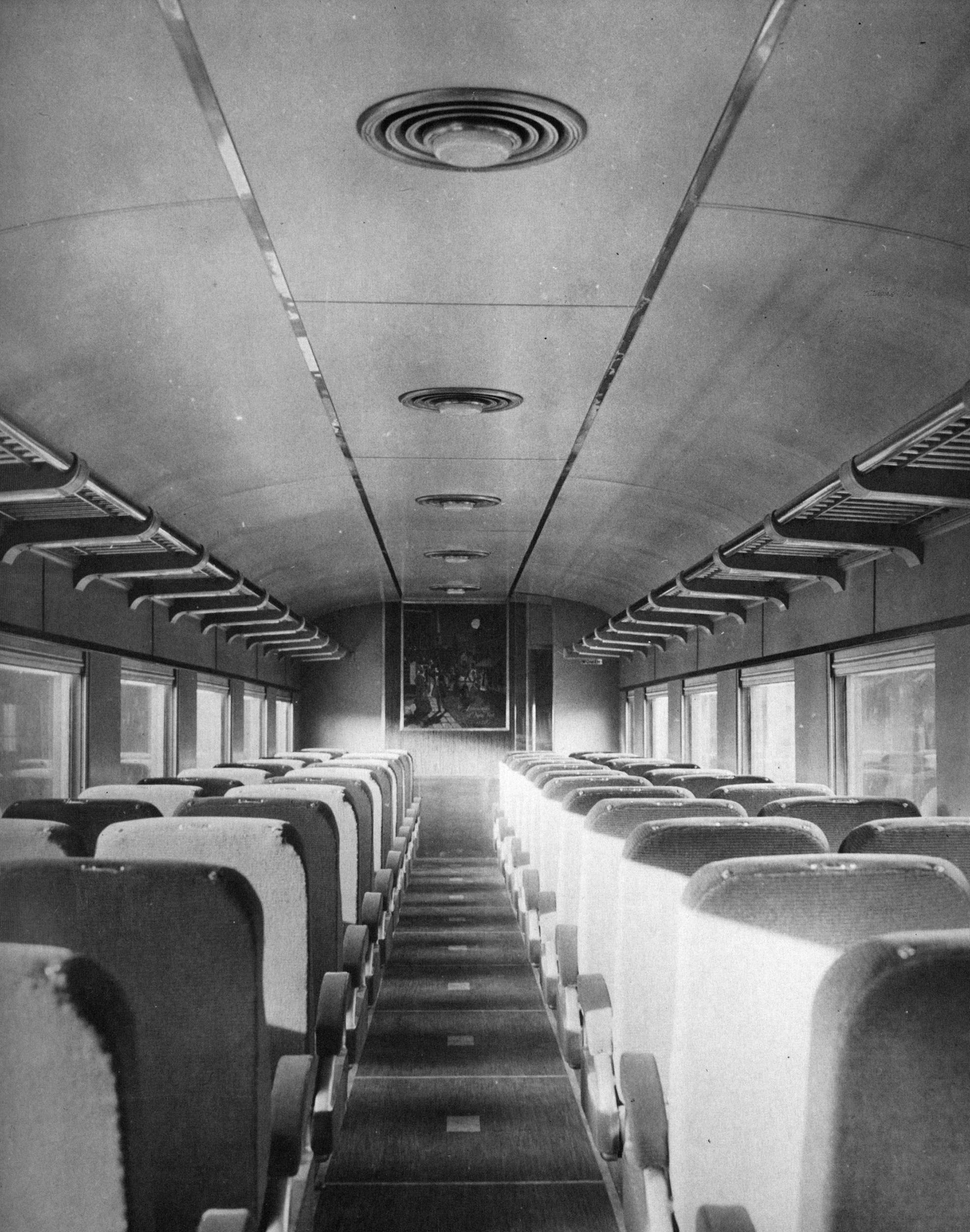 |
| Interior of Empire Service coach Source |
In Michigan, the Central had two long distance trains between Chicago, Detroit and New York City and a local train. Two of these became Amtrak day trains, only running between Chicago and Detroit, but Amtrak never restored the latter’s connection to New York City.
Two disconnected trains ran between Cleveland, Columbus and Cincinnati and one connected Cleveland with Indianapolis. The James Whitcomb Riley running between Chicago, Indianapolis and Cincinnati was combined with the C&O’s George Washington.
Pennsylvania Railroad
Unlike the New York Central, the Pennsy had not been able to pare back its passenger trains although it was not for lack of effort. In the late 1960’s, the railroad proposed discontinuing all passenger trains west of Harrisburg to no avail.
Like the Central, the Pennsylvania also ran three trains between New York City and Chicago, all retaining their names as the Broadway Limited, Manhattan Limited and Pennsylvania Limited. There was also a train to St. Louis, the Spirit of St. Louis with a section splitting in Columbus called the Cincinnati Limited.
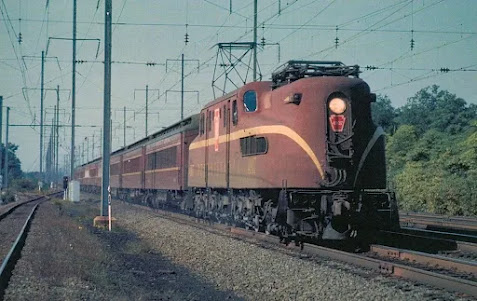 |
| Pennsylvania Railroad GG1 electric locomotive Source |
An unnamed day-train linked Pittsburgh and Columbus with Indianapolis and St. Louis. The day-train Duquesne linked New York City, North Philadelphia, Harrisburg and Pittsburgh while the Juniata made the same run but started in Philadelphia instead of New York City. The Duquesne was saved by Amtrak and is now known as the Pennsylvanian. Eight trains connected Philadelphia with Harrisburg, several operating on a commuter rail type schedule, and were retained by Amtrak, eventually becoming the popular Keystone Service. An unnamed day-train ran between Chicago, Logansport, IN and Cincinnati was dropped. Another nameless day-train connected Pittsburgh with Fort Wayne and Chicago was also dropped.
From Harrisburg to Baltimore, a single round-trip connected the two cities with a single stop in York. By 1971, the Buffalo Day Express had lost its name and only ran between Harrisburg and Buffalo with no connections for passengers headed to Baltimore and Washington, DC. Neither the former Day Express and Harrisburg to Baltimore via York service were retained although Amtrak operated a section of the Broadway Limited via the parallel Port Road Branch from Washington, Baltimore and Harrisburg.
Seaboard Coast Line Railroad
After the Florida East Coast Railway’s 1965 labor strike, all long distance passenger trains moved to the Seaboard line’s serving the interior. Other railroads such as the Illinois Central, L&N, and Pennsylvania hosted Florida-bound service. Six daily trains connected New York City to Florida. Everglades, Florida Special, Champion and Gulf Coast Special served Charleston (SC). The Gulf Coast split in Richmond with a section called the Palmland served Raleigh and Columbia. The Silver Meteor and Silver Star also served Raleigh and Columbia. Amtrak retained the two Silver Florida trains and the Champion but after combining it with the Silver Meteor at times, it was eventually discontinued in 1979. The Champion had several sections with service to Naples, Sarasota and Montgomery, AL, which were all dropped. In Jacksonville, the Silver Star split into two sections, one to Miami and the other to St. Petersburg. This split was initially retained by Amtrak but nowadays, the train runs to Tampa where it doubles back to serve Miami.
Chicago had two thrice weekly services on two separate routes. The City of Miami used the Illinois Central line from Chicago to Fulton, KY and then followed the L&N line to Nashville, Birmingham and Montgomery and then used the Seaboard to access Florida. Amtrak dropped the City of Miami in favor of the South Wind which served more populous cities such as Indianapolis, Louisville and Nashville. Both trains combined in Jacksonville to serve Florida on a single route through Orlando to Miami. The South Wind was renamed the Floridan in late 1971 and bypassed Indianapolis in search of better maintained track. The Floridan ended in 1979 although in 2024, was temporary restored by combining the Capitol Limited with the Silver Star in Washington, DC.
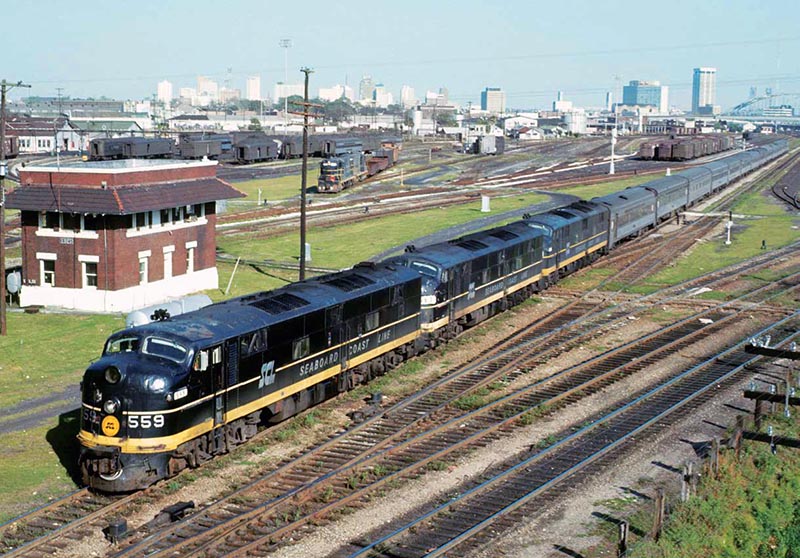 |
| Silver Meteor near Jacksonville on April 23, 1971 from Robert Olsesski, Ken Donnelly collection Source |
Southern Pacific RailroadSimilar to the L&N, the SP spent years pruning its passenger network prior to 1971. The Sunset Limited was retained by Amtrak although after more than 50 years, it still runs just thrice weekly on a similar schedule. It no longer serves Phoenix as the Union Pacific abandoned track west of Phoenix in 1996 but exchanges cars with the Texas Eagle to provide service to Dallas, St. Louis and Chicago. Amtrak retained the Cascade which connected Oakland with Portland, renaming it the Coast Starlight and extending it to Seattle, Sacramento and Los Angeles, the latter segment replacing the Coast Daylight service. Connecting San Francisco with San Jose and Monterey, the Del Monte was not retained by Amtrak although Caltrain runs as far as Gilroy.
The San Joaquin Daylight was not initially included in the Amtrak system but resumed in 1974 with state support. Its terminus moved from Los Angeles to Bakersfield, avoiding the slow and congested Tehachapi Pass. Amtrak’s San Joaquin uses the former Santa Fe line which has a slighter higher top speed and less freight traffic. Metrolink commuter trains use its former route from Lancaster to Los Angeles but Amtrak’s attempts to extend the San Joaquin back to Los Angeles were stymied by Southern Pacific opposition in 1980. Amtrak also declined to retain a thrice-weekly unnamed service that was mixed with freight cars from Santa Rosa to Eureka via the scenic but maintenance-intense Eel River canyon.
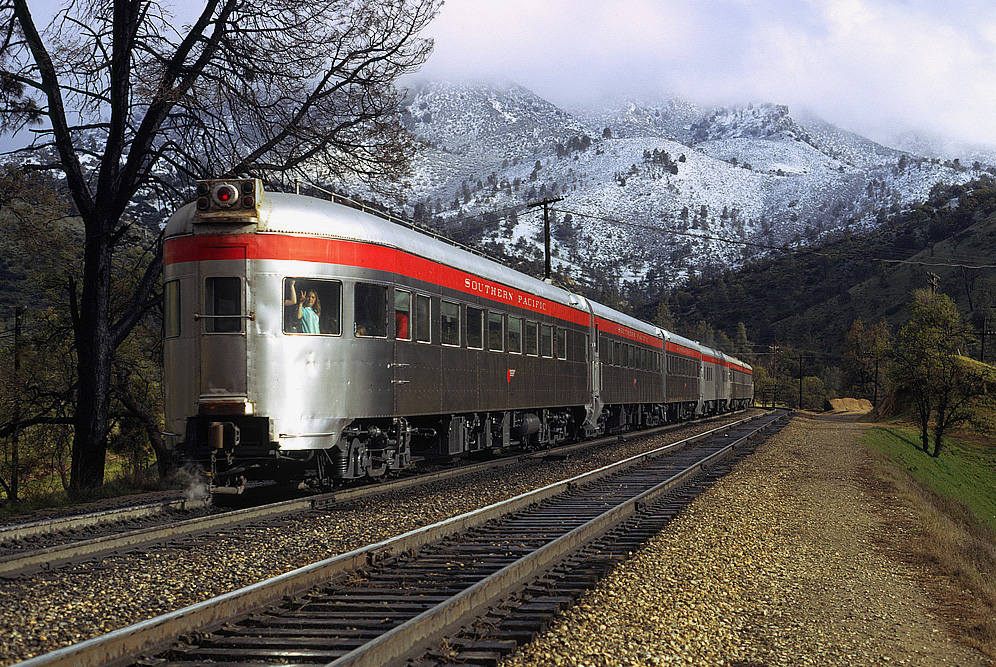 |
San Joaquin Daylight in March 1971 Source |
The SP also hosted the thrice weekly City of San Francisco which ran from Chicago to Cheyenne and Ogden via Milwaukee Road and Union Pacific track before switching to the SP in Ogden. Amtrak retained this service as the thrice weekly San Francisco Zephyr and rerouted it via Denver.
Union Pacific Railroad
In 1969, the UP had largely combined its passenger services into a single “City of Everywhere” mega train with up to 27 cars. A single train departed Chicago and a section for Denver was split off in North Platte as the City of Denver. In Green River, WY, the City of Portland section left to serve Boise and its namesake, leaving behind the City of Los Angeles bound for Ogden, Salt Lake City, Las Vegas and its namesake. In Ogden, another section split off as the City of San Francisco, running thrice weekly on SP track to Oakland.
The Portland Rose ran from Denver to Cheyenne, Boise and Portland. Amtrak only kept the Denver to Cheyenne segment as the San Francisco Zephyr but resumed service to Portland and Seattle as the Pioneer between 1977 and 1997.
 |
"City of Everywhere" 9/16/67 Source
|
UP had two trains between Denver and Kansas City, albeit one served Kansas City, KS as an unnamed day train that also hauled freight cars (known as a mixed train). The City of Kansas City ran overnight. Neither train was saved by Amtrak.



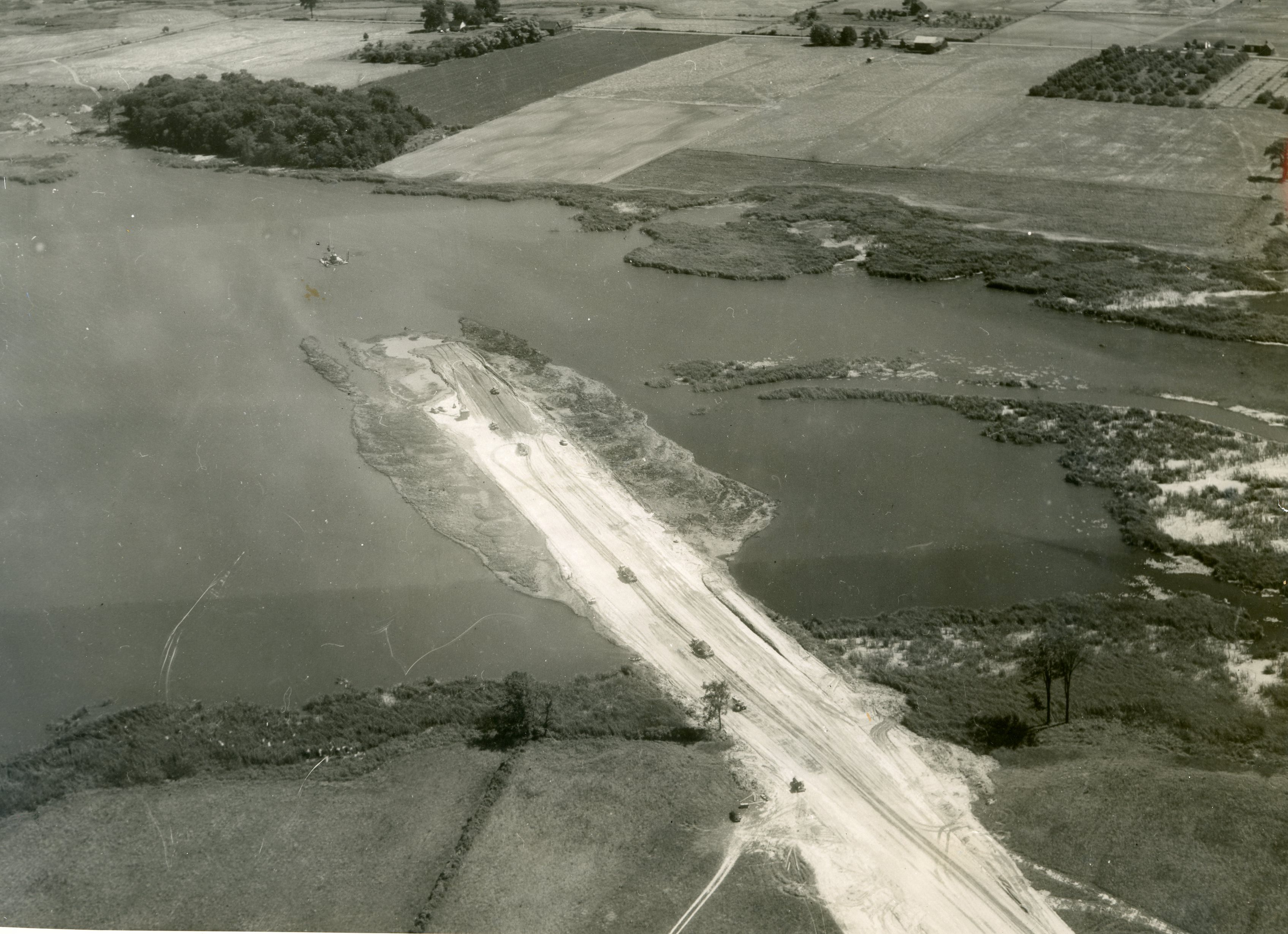









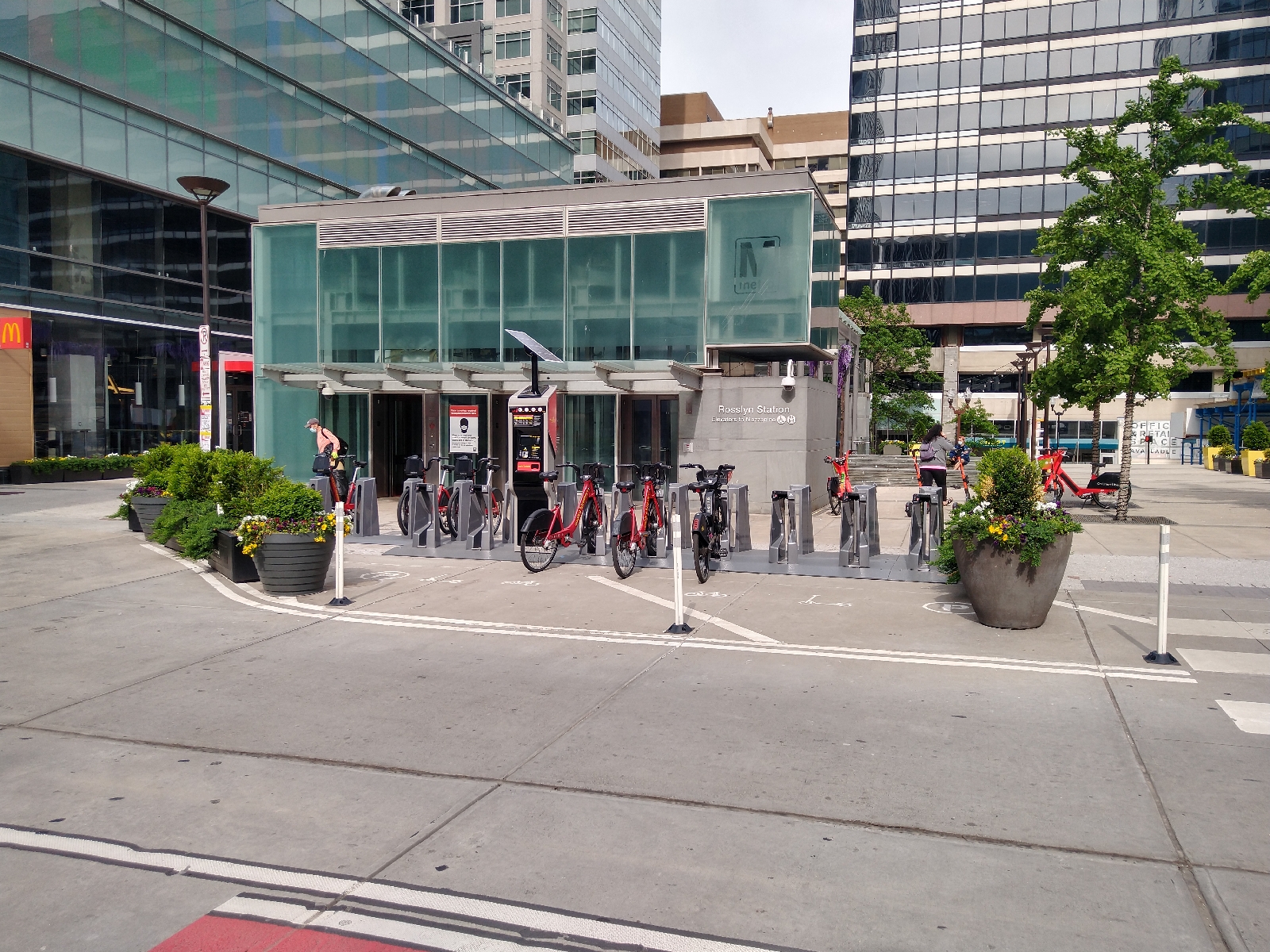

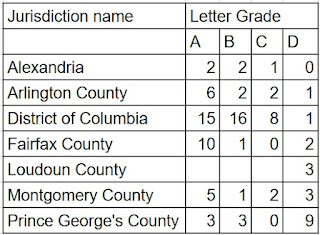



.jpg)







